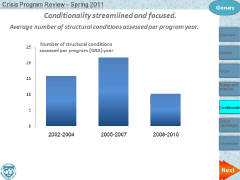Spring 2011
Review of Crisis Programs
Last Updated: July 28, 2017
This presentation reviews new non-concessional IMF-supported programs that were started since the global crisis began in 2008. It updates the original crisis programs review paper published in September 2009. The
new update confirms the main messages of that paper regarding the original wave of countries that turned to the Fund in the heat of the crisis: the Fund took a more flexible and accommodating role to program design, responding to individual country needs and helping countries to avoid worse economic outcomes during the crisis, with higher and more frontloaded financing. This update now includes a second wave countries that adopted IMF-supported programs since the original review: while many of these countries face different and often more protracted difficulties, program design and financing appears to be responding to their individual needs within a consistent framework with the earlier programs. Nevertheless many important challenges remain to ensure a return to sustainable growth in output and employment.
For illustrative purposes, the IMF-supported programs are compared to non-program countries, those with a Flexible Credit Line, and to past crisis cases.







